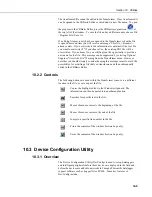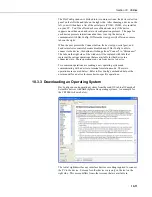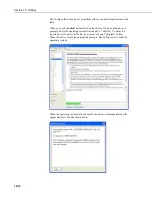
Section 10. Utilities
extension of either *.dat or a numeric value (e.g., *.000), depending upon
whether or not filemarks are processed (see below for information on file
formats and filemarks). For instance, the default name for a table called
MyData stored in TOA5 format would be TOA5_MyData.dat.
The destination directory or filename for a converted file can be changed on an
individual file basis. Click on the row for the file that you wish to change. It
will be highlighted. Select Options | Change Output File from the CardConvert
menu, and browse for or type in a new path and/or filename. You can apply a
directory path change to all files by selecting Options | Apply Directory to All.
You do not have to convert all files that are found in the selected directory.
Select one or more files for conversion by selecting or clearing the checkbox
beside the individual file name. If a box is checked the file will be converted; if
a box is cleared the file will not be converted. To quickly select or clear all
check boxes, choose Options | Check All or Clear Check All from the
CardConvert menu.
The list of files displayed for a particular drive or directory can be updated by
selecting Options | Rebuild File Lists from the menu. Any new files that have
been stored since you last selected the drive (or since the last rebuild), will be
added to the list.
Tip: Right-click within the file list to display a shortcut menu containing the
items on the Options menu.
10.1.2 Destination File Options
The Destination File Options determine whether the data will be stored on the
PC in ASCII or binary format, how filemarks will be processed, and what
should happen when existing files with the same name are found.
10.1.2.1 File Format
The File Format is used to specify the format in which the data file should be
saved. Select the desired option from the list box:
ASCII Table Data (TOA5) - Data is stored in an ASCII comma separated
format. Header information for each of the data values is included, along
with field names and units of measure if they are available.
Binary Table Data (TOB1) - Data is stored in a binary format. Though
this format saves disk storage space, it must be converted before it is
usable in other programs.
Array Compatible CSV - Data is stored in a user-defined comma
separated format. This option can be used to produce output files from
table data dataloggers that are similar to those created by mixed array
dataloggers. When this option is chosen, the Array CSV Options button
becomes available, so that you can customize the data string for the CSV
file.
10-2
Summary of Contents for PC400
Page 2: ......
Page 16: ...Section 1 Introduction 1 6...
Page 18: ...Section 2 System Requirements 2 2...
Page 46: ...Section 4 The PC400 Main Screen 4 24...
Page 49: ...Section 5 Split 5 3...
Page 82: ...Section 5 Split 5 36...
Page 114: ...Section 6 View 6 14...
Page 132: ...Section 7 Short Cut Program Generator 7 18...
Page 188: ...Section 9 Datalogger Program Creation with CRBasic Editor 9 30...
Page 230: ...Appendix B Table Based Dataloggers B 12...
Page 249: ......
















































